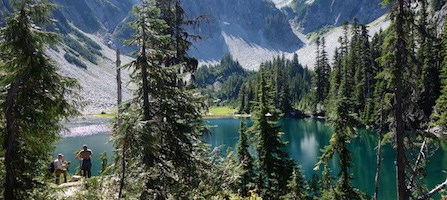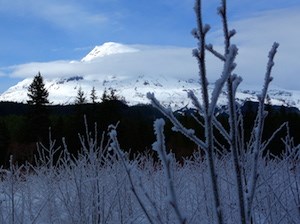
NPS Photos Places To GoMount Rainier has five developed areas: Longmire, Paradise, Ohanapecosh, Sunrise, and Carbon River & Mowich. Although the level of development in these areas ranges from basic (little more than a campground and picnic area) to extensive (hotel, restaurant, visitor center, campgrounds, and picnic areas), each can serve as a base for exploring the rest of the park. Basic InformationEssential information necessary to plan your visit includes fees, hours of operation, road status, weather, and current conditions. Print or download trail maps and other brochures before your visit. All this and more can be found under Basic Information. Directions & TransportationDirections to the park's five entrances from the surrounding areas, as well as maps of the park. Eating and SleepingLearn about lodging, restaurants, and campgrounds within Mount Rainier National Park. 
NPS Photo Things To DoFrom hiking and climbing, to wildflower viewing and ranger-led programs, there are a variety of things to do at Mount Rainier. CalendarInformation about events, programs, and fee free days. SafetyMount Rainier can be extremely dangerous if you are not prepared. Learn about geohazards, hiking safety, wildlife safety, and winter safety to ensure an enjoyable visit. 
NPS Photo Winter at Mount RainierWhile many park facilities and roads close during the winter months, winter also brings new opportunities for enjoying the park. Learn about winter recreation and winter travel. AccessibilityAlthough many of the developed areas at Mount Rainier National Park predate laws requiring fully accessible facilities, we are working to ensure that all visitors can experience and enjoy the park. Learn more about accessibility in the different areas of the park. Nearby AttractionsMount Rainier is within a half–day's drive of numerous recreational and educational opportunities in the Pacific Northwest. Transcript
Narrator 1: Welcome to Mount Rainier National Park. Covering almost three hundred seventy square miles, the park is home to not only iconic Mount Rainier but thousands of acres of pristine wilderness made up of everything from subalpine meadows and old growth forest to glacier carved valleys and a volcanic peak. Whether you have a day or all summer to explore, every corner of the park has something amazing to discover.
Narrator 2: We begin our exploration in the northwest corner of the park, home to the Carbon River and Mowich Lake. Narrator 1: Carbon River is one of the best areas in the park to see the dynamic effects of water in shaping Mount Rainier. From the Carbon Glacier the longest, deepest, and lowest-elevation glacier in the park to the Carbon River itself, water is a powerful sculpting force that continually changes this landscape. As one of the rainiest places in the park, the Carbon River area is home to a temperate rain forest. Learn about the plants and animals of this rain forest by following the easy, self-guided rain forest nature trail, that begins near the Carbon River entrance. In 2006, a massive flood damaged much of the historic Carbon River road. Now the road is closed to vehicles, but is open for bike riding and hiking. Pristine Mowich Lake, located not far from Carbon River, is open from July to October. A starting point for several popular hiking trails, Mowich Lake also has a backcountry campground. Narrator 2: The Nisqually Entrance is located in the southwest corner of the park and serves as the historic gateway to the Longmire and Paradise areas of the park. Narrator 1: Westside Road, a popular access point for hiking, branches off the main road not far from the Entrance. Like the Carbon River Road, Westside Road has been shaped many times by flooding and debris flows. Evidence of these dynamic processes can be seen clearly along the road. As you continue the drive up to Longmire, pause at Kautz Creek for one of the first views of the mountain visible in the park along this road. Or a little farther, walk the short Twin Firs Loop Trail for an introduction to the park's old growth forest. Longmire was the first settlement in the park and is preserved as a National Historic Landmark District. The story of the park's early history can still be found along the Trail of the Shadows and historic walking tour through Longmire. Volcanic mineral springs that supported the early Longmire settlement still bubble in the Longmire meadow. The road itself from Nisqually Entrance up to Paradise is also part of the Historic Landmark District. Designed specifically to provide the best experience for visitors, the winding road dramatically reveals the mountain and its terrain, from glacier carved valleys and lava ridges to waterfalls and old growth forest. Favorite stops between Longmire and Paradise include Christine and Narada Falls, or you can camp at Cougar Rock Campground. Many trails can be accessed from the road with options to hike along glacier rivers and lava ridges or to explore subalpine meadows. Paradise, well deserving of its name, is the most popular destination in the park. Home to the Paradise Inn and the Jackson Visitor Center, this area has many amenities for the first time visitor. In winter the area remains open for snowshoeing, sledding, and other winter activities. In summer and fall, hike through subalpine meadows thick with wildflowers or fall foliage. As you leave Paradise, enjoy a drive down the Paradise Valley Road, a favorite route for viewing spring wildflowers or fall colors. Keep an eye out for birds, marmots, deer, bears, and other wildlife enjoying the valley. Narrator 2: The historic Stevens Canyon Road descends from the subalpine meadows at Paradise to the heart of the old growth forest found in the Ohanapecosh area of the park. Narrator 1: Like Paradise Valley Road, Stevens Canyon Road is a popular drive for viewing fall colors as well as ephemeral waterfalls in spring. As you drive along the canyon don't forget to stop at some of the pullouts and look back for a magnificent view of Mount Rainier. Or make a day of it and hike one of the many trails along Stevens Canyon. Explore subalpine lakes, such as Bench and Snow Lakes, or Louise Lake. Hike the Pinnacle Peak trail in the Tatoosh mountains or follow part of the 93-mile Wonderland Trail that circles Mount Rainier. At Box Canyon, look over the side of an old stone bridge to view a deep narrow fissure eroded in the rock by the Muddy Fork of the Cowlitz River before continuing on to the Grove of the Patriarchs. The ancient trees that make up the Grove reside on an island in the middle of the clear, snow fed Ohanapecosh River. With trees hundreds of years old, the Grove of the Patriarchs epitomizes the feeling of age and majesty associated with true old growth forest. Those looking to enjoy a longer hike through the area's old growth forest can take the Eastside Trail, which branches off from the Grove of the Patriarchs trail. At Ohanapecosh stop in the visitor center before exploring the Hot Springs Nature Trail. Camp beneath the canopy of the forest in the Ohanapecosh Campground, or follow the trail leaving the campground to view the impressive Silver Falls. Narrator 2: Head north from Ohanapecosh to reach the White River and Sunrise areas in the northeast corner of the park. Narrator 1: Climbing up through forested valleys to mountain passes, the road north has many pullouts with spectacular views of the surrounding areas. Trails along the way lead to a historic fire lookout and connect to the famous Pacific Crest Trail, which crosses through the east side of the park. At Chinook Pass, walk across the historic entrance arch walking bridge, or enjoy the lush wildflower displays that fill the subalpine meadows ringing Tipsoo Lake. The White River area hosts the park's third campground and provides access to some of the park's east side trails such as Summerland and Owyhigh Lakes. A favorite hike is the Emmons Moraine Trail, offering amazing views of the Emmons glacier and Mount Rainier. The road from White River up to Sunrise is a journey through the geologic history of Mount Rainier. Starting in the White River valley carved by Ice Age glaciers and shaped by volcanic mud flows, the Sunrise Road climbs past layers of lava and ash from past eruptions to reach the lava ridge upon which Sunrise is built. Sunrise Point features 360-degree views of not only Mount Rainier but the surrounding Cascade mountains. On clear days you can see the volcanic peaks of Mount Adams and Mount Baker in the distance. Combined with the amazing views of the Emmons glacier and Mount Rainier, Sunrise is another popular summer destination in the park. The Sunrise area is open from July to September. Located on the drier east side of Mount Rainier, subapline meadows around Sunrise have a different character than areas that receive more rainfall like Paradise. Hiking opportunities abound, with trails leading through subalpine meadows and volcanic ridges. Where will your next Mount Rainier adventure take you? Will you stand at the foot of a glacier, gaze up at an ancient forest canopy, or surround yourself with wildflowers? Will you hike to a waterfall or relax next to a subalpine lake? Or will you stay for a while to enjoy the view? Plan your visit to Mount Rainier National Park by visiting the park website.
Visit our keyboard shortcuts docs for details
From the spectacular heights of Mount Rainier to the hidden depths of old growth forest, Mount Rainier National Park has much to discover. If you are unfamiliar with the park, this video provides a tour of just a few of the amazing things to see and explore in every corner of the park. Where will you go? |
Last updated: September 3, 2024
